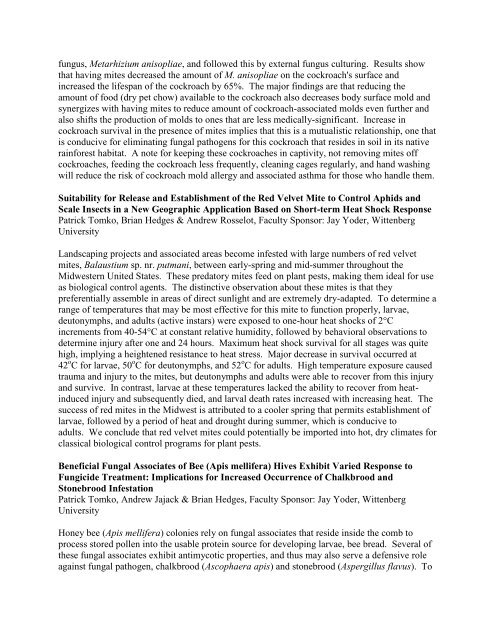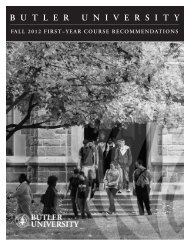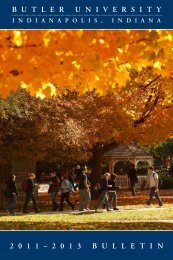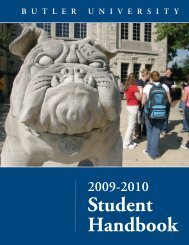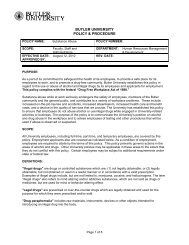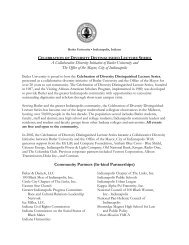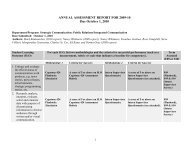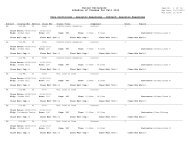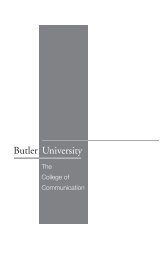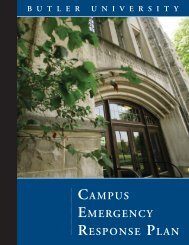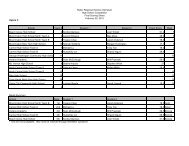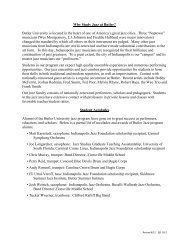Anthropology - Butler University
Anthropology - Butler University
Anthropology - Butler University
You also want an ePaper? Increase the reach of your titles
YUMPU automatically turns print PDFs into web optimized ePapers that Google loves.
fungus, Metarhizium anisopliae, and followed this by external fungus culturing. Results show<br />
that having mites decreased the amount of M. anisopliae on the cockroach's surface and<br />
increased the lifespan of the cockroach by 65%. The major findings are that reducing the<br />
amount of food (dry pet chow) available to the cockroach also decreases body surface mold and<br />
synergizes with having mites to reduce amount of cockroach-associated molds even further and<br />
also shifts the production of molds to ones that are less medically-significant. Increase in<br />
cockroach survival in the presence of mites implies that this is a mutualistic relationship, one that<br />
is conducive for eliminating fungal pathogens for this cockroach that resides in soil in its native<br />
rainforest habitat. A note for keeping these cockroaches in captivity, not removing mites off<br />
cockroaches, feeding the cockroach less frequently, cleaning cages regularly, and hand washing<br />
will reduce the risk of cockroach mold allergy and associated asthma for those who handle them.<br />
Suitability for Release and Establishment of the Red Velvet Mite to Control Aphids and<br />
Scale Insects in a New Geographic Application Based on Short-term Heat Shock Response<br />
Patrick Tomko, Brian Hedges & Andrew Rosselot, Faculty Sponsor: Jay Yoder, Wittenberg<br />
<strong>University</strong><br />
Landscaping projects and associated areas become infested with large numbers of red velvet<br />
mites, Balaustium sp. nr. putmani, between early-spring and mid-summer throughout the<br />
Midwestern United States. These predatory mites feed on plant pests, making them ideal for use<br />
as biological control agents. The distinctive observation about these mites is that they<br />
preferentially assemble in areas of direct sunlight and are extremely dry-adapted. To determine a<br />
range of temperatures that may be most effective for this mite to function properly, larvae,<br />
deutonymphs, and adults (active instars) were exposed to one-hour heat shocks of 2°C<br />
increments from 40-54°C at constant relative humidity, followed by behavioral observations to<br />
determine injury after one and 24 hours. Maximum heat shock survival for all stages was quite<br />
high, implying a heightened resistance to heat stress. Major decrease in survival occurred at<br />
42 o C for larvae, 50 o C for deutonymphs, and 52 o C for adults. High temperature exposure caused<br />
trauma and injury to the mites, but deutonymphs and adults were able to recover from this injury<br />
and survive. In contrast, larvae at these temperatures lacked the ability to recover from heatinduced<br />
injury and subsequently died, and larval death rates increased with increasing heat. The<br />
success of red mites in the Midwest is attributed to a cooler spring that permits establishment of<br />
larvae, followed by a period of heat and drought during summer, which is conducive to<br />
adults. We conclude that red velvet mites could potentially be imported into hot, dry climates for<br />
classical biological control programs for plant pests.<br />
Beneficial Fungal Associates of Bee (Apis mellifera) Hives Exhibit Varied Response to<br />
Fungicide Treatment: Implications for Increased Occurrence of Chalkbrood and<br />
Stonebrood Infestation<br />
Patrick Tomko, Andrew Jajack & Brian Hedges, Faculty Sponsor: Jay Yoder, Wittenberg<br />
<strong>University</strong><br />
Honey bee (Apis mellifera) colonies rely on fungal associates that reside inside the comb to<br />
process stored pollen into the usable protein source for developing larvae, bee bread. Several of<br />
these fungal associates exhibit antimycotic properties, and thus may also serve a defensive role<br />
against fungal pathogen, chalkbrood (Ascophaera apis) and stonebrood (Aspergillus flavus). To


